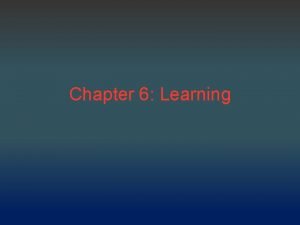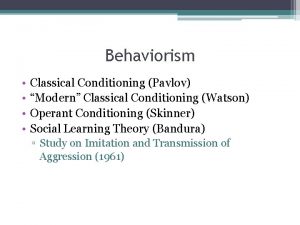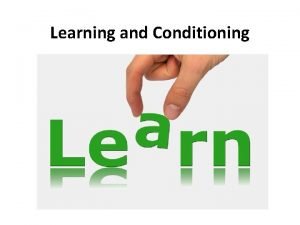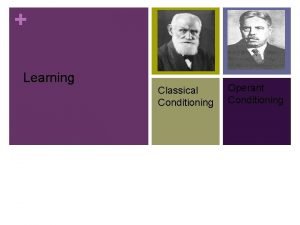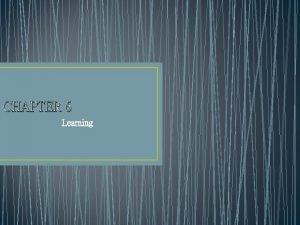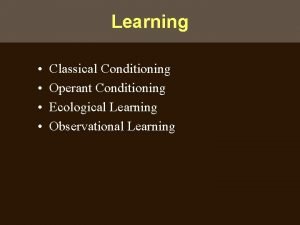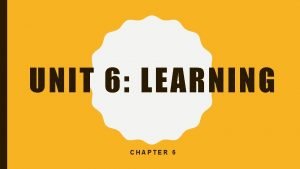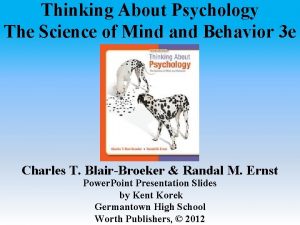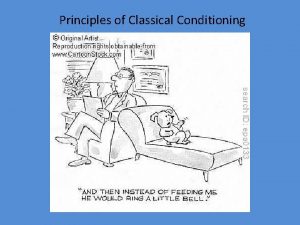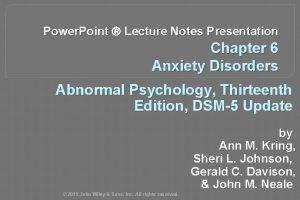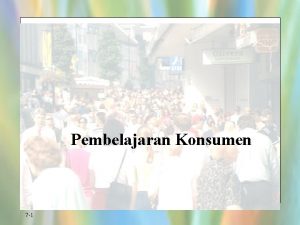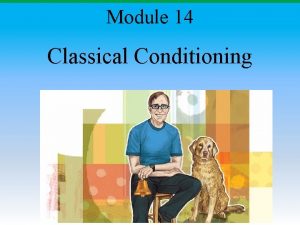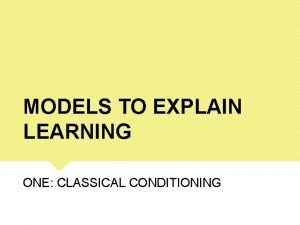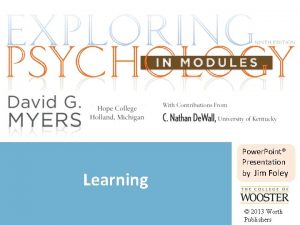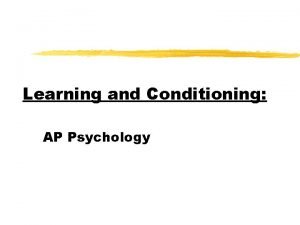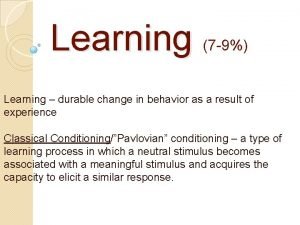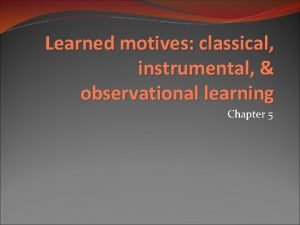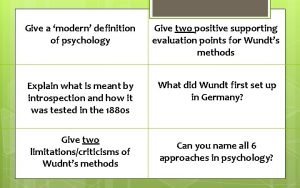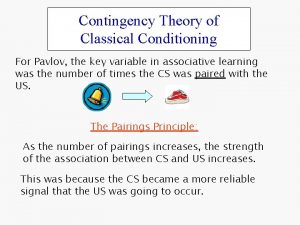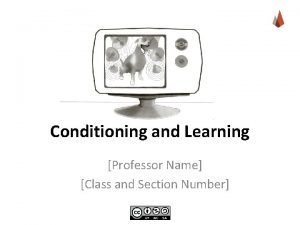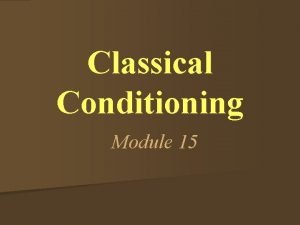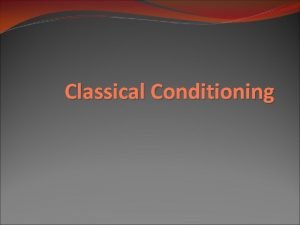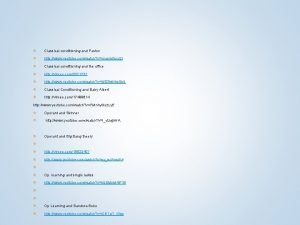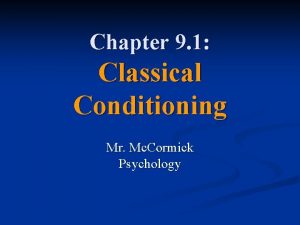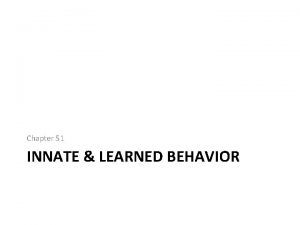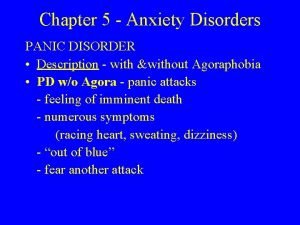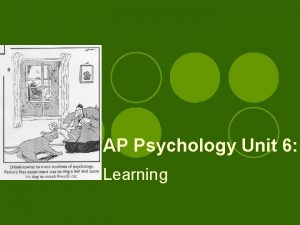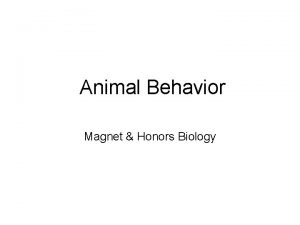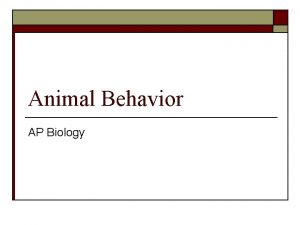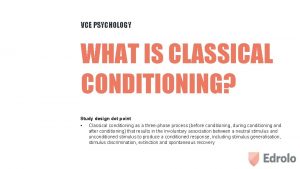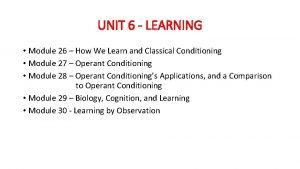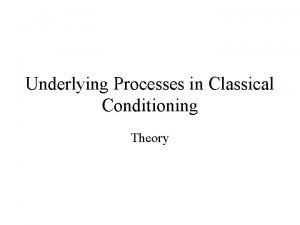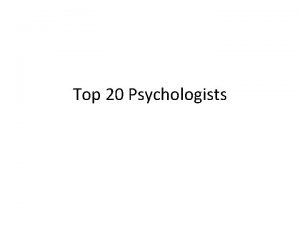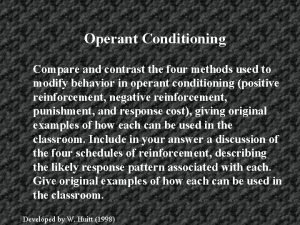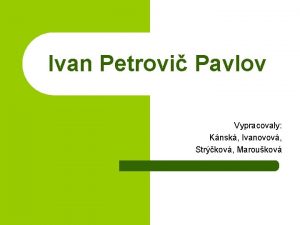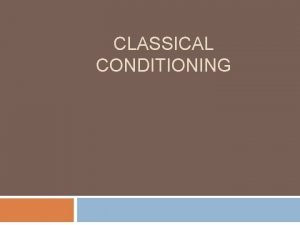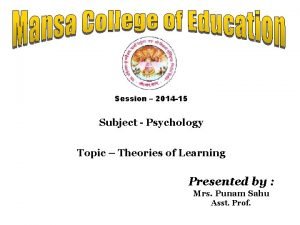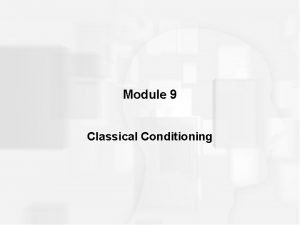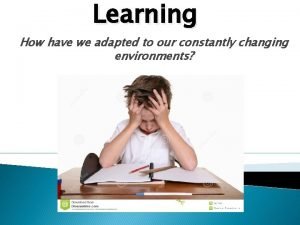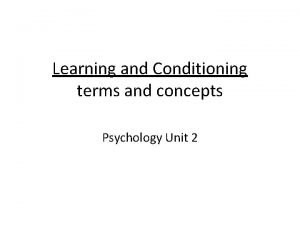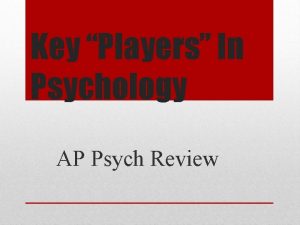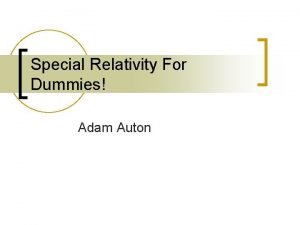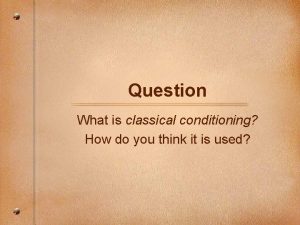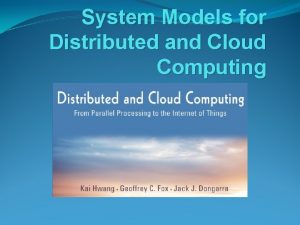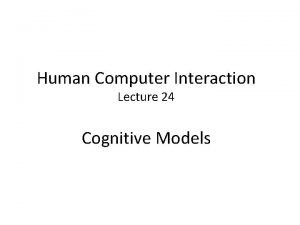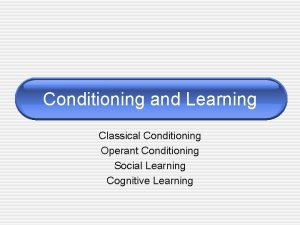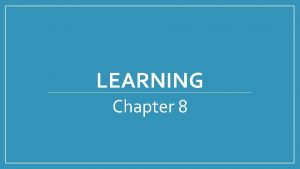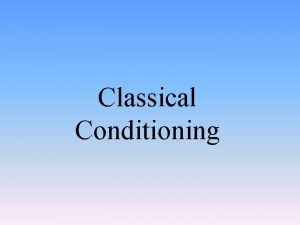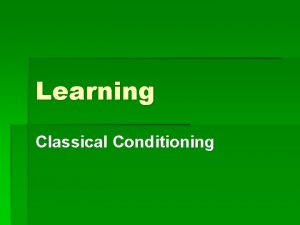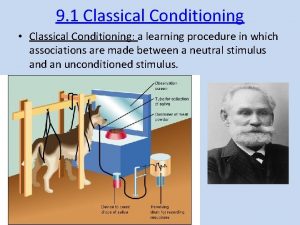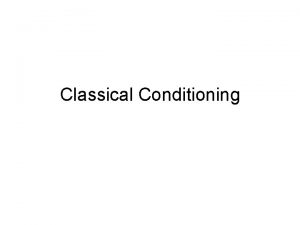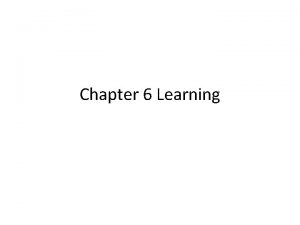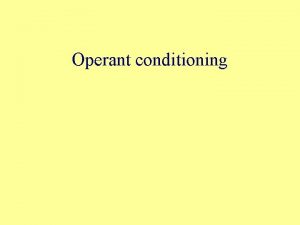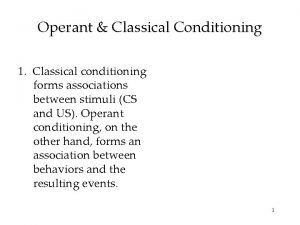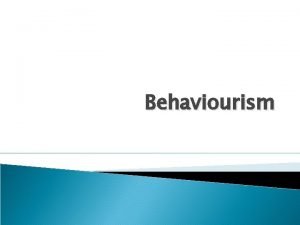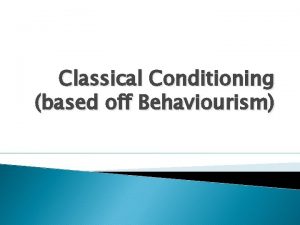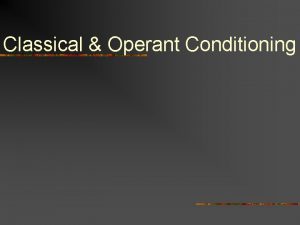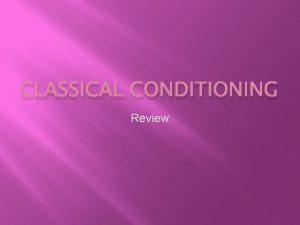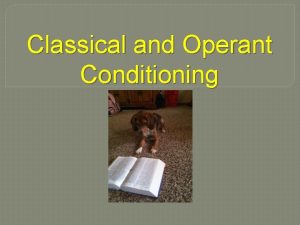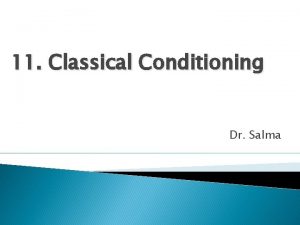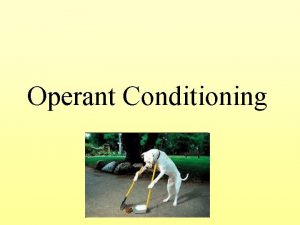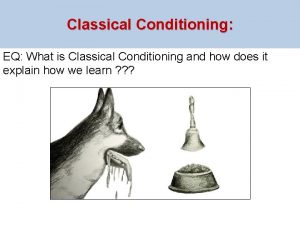MODELS TO EXPLAIN LEARNING ONE CLASSICAL CONDITIONING LEARNING






































































- Slides: 70

MODELS TO EXPLAIN LEARNING ONE: CLASSICAL CONDITIONING

LEARNING • a relatively permanent change in behaviour that occurs as a result of experience.


What does it mean to be conditioned?

CONDITIONING • the process of learning associations between a stimulus in the environment (one event) and a behavioural response (another event).

How do you use conditioning? Have you ever been conditioned?


CLASSICAL CONDITIONING

CLASSICAL CONDITIONING A form of learning based on the repeated association of two (or more) different stimuli.

CLASSICAL CONDITIONING Learning is only said to have occurred when a particular stimulus consistently produces a response that it did not previously produce.

PAVLOV https: //www. youtube. com/watch? v =q. G 2 Sw. E_6 u. VM

How to train a brain PAVLOV https: //www. youtube. com/watch? v =q. G 2 Sw. E_6 u. VM&t=166 s

PAVLOV STIMULUS Any object or event that elicits (produces) a response from an organism. RESPONSE a reaction by an organism to a stimulus.

3 PHASE MODEL No response Bell Food Salivation


3 PHASE MODEL Neutral stimulus Conditioned stimulus No response Unconditioned Stimulus Unconditioned response Conditioned response

Neutral stimulus No response Unconditioned Stimulus Conditioned stimulus Unconditioned response Conditioned response

1. UNCONDITIONED STIMULUS • The UCS is any stimulus that consistently produces a particular, naturally occurring, automatic response. • In Pavlov’s experiment: UCS = food

2. UNCONDITIONED RESPONSE • The UCR is the response that occurs automatically when the UCS is presented. • A UCR is a reflexive, involuntary response that is predictably caused by a UCS. • In Pavlov’s experiments UCR = salivation

3. CONDITIONED STIMULUS • The CS is the stimulus that is neutral at the start of the conditioning process and does not normally produce the UCR. • Through repeated association with the UCS, the CS triggers a very similar response to that caused by the UCS.

4. CONDITIONED RESPONSE • The CR is the learned response that is produced by the CS. • The CR occurs after the CS has been associated with the UCS. • The behaviour involved in a CR is very similar to that of the UCR, but it is triggered by the CS alone.

4. CONDITIONED RESPONSE



WORKSHEET 1

THE OFFICE • Write the 3 -phase model of CC using the example from The Office. • https: //www. youtube. com/watch? v=0 DQj. CPBZa. Uk

KEY PROCESSES

KEY PROCESSES ACQUISITIO N STIMULUS DISCRIMINATION STIMULUS GENERALISATION EXTINCTION SPONTANEOUS RECOVERY

ACQUISITION • Each paired presentation of the CS with UCS is referred to as a trial. • Acquisition is the overall process during which the organism learns to associate 2 events. • The rate of learning is often very fast in the early stages of the acquisition phase.

ACQUISITION • Timing of the CS and UCS pairing is critical. • A short time between presentations of the 2 stimuli is most effective. • Acquisition is more rapid when the CS occurs and remains present until the UCS is presented. • The end of the acquisition stage is said to occur when the CS alone produces the CR.

EXTINCTION • A conditioned stimulus-response association can fade over time or disappear altogether. • Extinction is the gradual decrease in the strength or rate of a CR that occurs when the UCS is no longer presented. • Extinction is said to have occurred when a CR no longer occurs following presentation of the CS.

EXTINCTION • E. g. Pavlov’s dogs eventually ceased salivating (CR) in response to the bell (CS) presented alone after a number of trials in which the food (UCS) did not follow the sound of the bell). • There is also considerable variation between the rates at which different response will be extinguished.

SPONTANEOUS RECOVERY • Extinction of a CR is not always permanent. • In CC, spontaneous recovery is the reappearance of a CR when the CS is presented, following a rest period after the CR appears to have been extinguished.

SPONTANEOUS RECOVERY • Spontaneous recovery does not always occur and when it does it is often shortlived. • Furthermore the CR tends to be weaker than it was originally.

STIMULUS GENERALISATION • Pavlov observed that his dogs salivated to other noises that sounded like a bell. • This is known as stimulus generalisation which is the tendency for another stimulus to produce a response that is similar to the CR. • The greater the similarity between stimuli, the greater the possibility that a generalisation will occur.

STIMULUS GENERALISATION However, the amount of saliva produced by the dog would tend to be less than the amount produced by the original bell to which the dog was conditioned.

STIMULUS DISCRIMINATION Stimulus discrimination occurs when a person or animal responds to the CS only, but not to any other stimulus that is similar to the CS.

STIMULUS DISCRIMINATION • E. g. in a CC experiment, stimulus discrimination would be observed when a dog salivated only in response to the sound of the ‘experimental bell’, and not in response to any other similar sound such as a door bell.

KEY PROCESSES the ability to distinguish between two (or more) different stimuli, even if the stimuli are STIMULUS DISCRIMINATIO similar the process through which an organism learns to associate two events (CS & UCS ACQUISITION N the tendency for similar stimuli to produce the same, but not necessarily identical, response STIMULUS GENERALISATIO N EXTINCTION SPONTANEOU S RECOVERY the gradual decrease in the strength or rate of a response, occurs over time when the UCS is not presented the reappearance of a conditioned response after its apparent extinction

Fill in the gaps

Words to choose from acquisition conditioned response extinction unconditioned stimulus generalisation stimulus discrimination neutral stimulus






Practice exam questions

Question 1 One Saturday, Lacey was sitting at home when the telephone rang. A local company was making promotional calls and told Lacey she had just won a $1000 gift certificate. She felt a rush of excitement at the thought of what she could do with $1000. Now Lacey finds that whenever she hears a telephone ring, she feels a surge of excitement. In this example, the rush of excitement that Lacey felt when she heard she had won the gift certificate is a) The unconditioned response b) the conditioned response c) the unconditioned stimulus d) the conditioned stimulus

Question 1 One Saturday, Lacey was sitting at home when the telephone rang. A local company was making promotional calls and told Lacey she had just won a $1000 gift certificate. She felt a rush of excitement at the thought of what she could do with $1000. Now Lacey finds that whenever she hears a telephone ring, she feels a surge of excitement. In this example, the rush of excitement that Lacey felt when she heard she had won the gift certificate is a) The unconditioned response b) the conditioned response c) the unconditioned stimulus d) the conditioned stimulus

Question 2 Mariah developed a fear of the water when she fell off a river raft last summer. This year she took swimming lessons and thought she had finally overcome her fear of water. She was eagerly looking forward to an upcoming rafting trip, however, as soon as she stepped onto the raft she was instantly terrified again. This illustrates the classical conditioning process known as a. second-order conditioning b. spontaneous recovery c. extinction d. stimulus generalization

Question 2 Mariah developed a fear of the water when she fell off a river raft last summer. This year she took swimming lessons and thought she had finally overcome her fear of water. She was eagerly looking forward to an upcoming rafting trip, however, as soon as she stepped onto the raft she was instantly terrified again. This illustrates the classical conditioning process known as a. second-order conditioning b. spontaneous recovery c. extinction d. stimulus generalization

Question 3 When a conditioned response shows spontaneous recovery, the rejuvenated response typically a. occurs before the conditioned stimulus b. changes to an unconditioned stimulus c. is weaker than the previously conditioned response d. is stronger than the previously conditioned response

Question 3 When a conditioned response shows spontaneous recovery, the rejuvenated response typically a. occurs before the conditioned stimulus b. changes to an unconditioned stimulus c. is weaker than the previously conditioned response d. is stronger than the previously conditioned response

Question 4 Stimulus generalization occurs when a) an organism responds to new stimuli that are similar to the original conditioned stimulus b) there is a temporal association between two stimuli c) an organism fails to respond to stimuli that are similar to the original stimulus used in conditioning d) an unconditioned stimulus fails to elicit the unconditioned response

Question 4 Stimulus generalization occurs when a) an organism responds to new stimuli that are similar to the original conditioned stimulus b) there is a temporal association between two stimuli c) an organism fails to respond to stimuli that are similar to the original stimulus used in conditioning d) an unconditioned stimulus fails to elicit the unconditioned response

CONDITIONED EMOTIONAL RESPONSE An emotional reaction that usually occurs when the nervous system produces a response to a stimulus that did not previously trigger that response.

How to train a brain Little Albert https: //www. youtube. com/watch? v =q. G 2 Sw. E_6 u. VM&t=166 s

J. B Watson and Rosalie Rayner

Watson promoted new ideal: • Coined the term ‘behaviorism’. Rejected the idea of consciousness. • According to Watson, scientists could best study human mind by noting what humans do.

What was claimed… “Give me a dozen healthy infants, wellformed, and my own special world to bring them up in, and I’ll guarantee to take any one at random and train him to become any type of specialist I might select: doctor, lawyer, artist, merchant chief, and, yes, beggar man and thief, regardless of his talents, penchants, tendencies, abilities, vocations and race of his ancestors. ” - J. B. Watson, 1924

Little Albert

• Little Albert B. , a healthy, stable 9 -month-old baby. • Shown a live rat, a rabbit, a dog, and a monkey. he would show no fear. • But he cried when a researcher struck a hammer against a steel bar. • Hopkins psychology professor John B. Watson and his assistant, Rosalie Rayner, then made a clanging sound each time the boy touched the rat.


Neutral Stimuli for Little Albert (things that were generally


Sequence of Stimulus Presentations to Albert on Fourth Day of Testing 1. Blocks- played with blocks as usual 2. Rat- fearful withdrawal but no crying Rat + Noise = fear and crying 4. Rat = fear and crying 5. Rat = fear, crying, and crawling away 6. Rabbit = fear, but less intense 3. 7. Blocks- played as usual 8. Rabbit- same as #6 9. Rabbit- same as #6 Rabbit = some fear, but wanted to touch rabbit 10. 11. Dog = fearful Dog + Noise = fear and crawling away 12. 13. Blocks- normal playing

ETHICAL CONCERNS • Little Albert did not recondition (recover from his fear) • However, some feel that Little Albert’s fear would subside over time • This is called extinction

OUTCOMES • Little Albert's mother was only paid $1 for her and her sons participation • Douglas Merritte “Little Albert” eventually died at age 6 of acquired hydrocephalus • "water on the brain meaning that there is an abnormal accumulation of cerebrospinal fluid in the ventricles, or cavities, of the brain

ETHICS Due to the age that Little Albert was during the time of the experiment, in today’s terms it would be deemed unethical

3 PHASE MODEL
 Operant conditioning vs classical conditioning
Operant conditioning vs classical conditioning Little albert experiment summary
Little albert experiment summary Classical and operant conditioning.
Classical and operant conditioning. Instrumental learning vs classical conditioning
Instrumental learning vs classical conditioning Classical and operant conditioning.
Classical and operant conditioning. Difference between operant and classical conditioning
Difference between operant and classical conditioning Fixed-ratio schedule example
Fixed-ratio schedule example Operant conditioning vs classical conditioning
Operant conditioning vs classical conditioning Classical conditioning vs operant conditioning
Classical conditioning vs operant conditioning Operant conditioning classical conditioning
Operant conditioning classical conditioning Different types of reinforcement schedules
Different types of reinforcement schedules Classical conditioning table
Classical conditioning table Real life example of classical conditioning
Real life example of classical conditioning Little albert experiment summary
Little albert experiment summary Pavlov's dog
Pavlov's dog Order of classical conditioning
Order of classical conditioning Classical conditioning panic disorder
Classical conditioning panic disorder Contoh iklan classical conditioning
Contoh iklan classical conditioning Law of effect thorndike
Law of effect thorndike Pavlov method
Pavlov method Unconditioned stimulus unconditioned response
Unconditioned stimulus unconditioned response Outline pavlov's classical conditioning
Outline pavlov's classical conditioning Neutral stimulus becomes a conditioned stimulus
Neutral stimulus becomes a conditioned stimulus Latent learning ap psychology
Latent learning ap psychology Classical conditioning generalization
Classical conditioning generalization What is classical conditioning example
What is classical conditioning example Little albert classical conditioning
Little albert classical conditioning Contingency theory rescorla
Contingency theory rescorla Behaviorism
Behaviorism Spontaneous recovery psychology
Spontaneous recovery psychology Garcia effect
Garcia effect Ivan pavlov classical conditioning
Ivan pavlov classical conditioning Mr cormick
Mr cormick Learned vs innate behavior
Learned vs innate behavior Classical conditioning panic disorder
Classical conditioning panic disorder Garcia effect
Garcia effect Classical conditioning biology
Classical conditioning biology Innate and learned behavior
Innate and learned behavior Generalization classical conditioning
Generalization classical conditioning Classical conditioning game
Classical conditioning game 5 elements of classical conditioning
5 elements of classical conditioning Unit 6 module 26 ap psychology
Unit 6 module 26 ap psychology Preparatory response theory example
Preparatory response theory example Pavlov classical conditioning
Pavlov classical conditioning Fixed interval schedule example
Fixed interval schedule example Classical conditioning adalah
Classical conditioning adalah Classical conditioning in teaching
Classical conditioning in teaching Unconditioned stimulus example
Unconditioned stimulus example S-r bond theory
S-r bond theory Classical conditioning
Classical conditioning Psychology dog experiment
Psychology dog experiment Pavlovian conditioning
Pavlovian conditioning Classical conditioning
Classical conditioning Adam auton
Adam auton Clockwork orange classical conditioning
Clockwork orange classical conditioning Classical conditioning in football
Classical conditioning in football Semi-modals
Semi-modals Classical french menu
Classical french menu All resources are tightly coupled in computing paradigm of
All resources are tightly coupled in computing paradigm of Bnf in hci
Bnf in hci One god one empire one religion
One god one empire one religion One one one little dogs run
One one one little dogs run One king one law one faith
One king one law one faith One god one empire one emperor
One god one empire one emperor Ford one plan
Ford one plan See one do one teach one
See one do one teach one One price policy
One price policy Willow cabin speech
Willow cabin speech Studiendekanat uni bonn
Studiendekanat uni bonn One vision one identity one community
One vision one identity one community Graphic organizer with the aims of la liga filipina
Graphic organizer with the aims of la liga filipina







